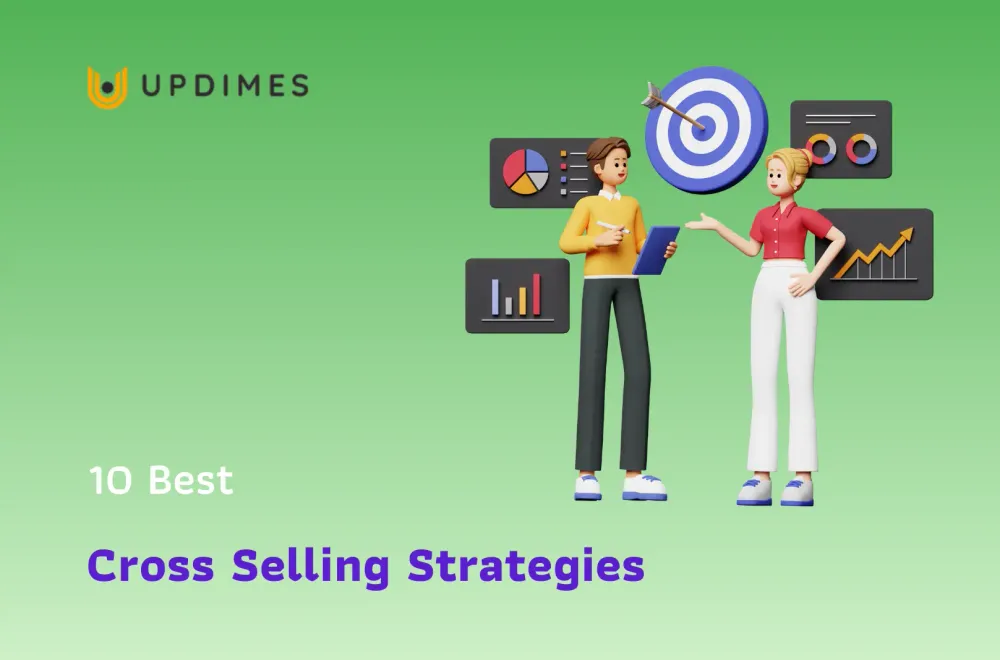10 Best Cross Selling Strategies That Help You Increase Revenue

In today's high competitive marketplace, almost all businesses are always seeking innovative strategies to drive revenue and foster customer loyalty. One highly effective approach that has proven is cross-selling. By strategically recommending complementary products or services to customers during the buying process, you can not only increase their average order value but also enhance the overall shopping experience.
In this article, we'll explore the top 10 cross-selling strategies that have been instrumental in boosting revenue and cultivate lasting relationships with customers. From personalized recommendations to targeted follow-up emails, these strategies offer valuable insights and actionable tactics for maximizing sales opportunities and driving sustainable growth.
What is Cross Selling?
Cross-selling is the practice of suggesting related or complementary products or services to customers who are already in the process of making a purchase, as part of a strategic sales technique. This approach aims to increase the total value of the transaction by encouraging customers to buy additional items that enhance or complement their original purchase.
For instance, when purchasing a laptop, a salesperson might recommend a laptop bag, antivirus software, or an extended warranty. Similarly, when buying a smartphone, customers may be prompted to consider screen protectors, phone cases, or insurance plans. By offering these additional options, you not only boost revenue but also enhance customer satisfaction by catering to their diverse needs and preferences.
Cross-selling relies heavily on providing accurate and comprehensive product information to customers. Without reliable data, customers might feel misled, leading to dissatisfaction and loss of trust in your brand.
Benefits of Cross Selling
Cross-selling presents a multifaceted array of benefits that resonate across various dimensions of business operations:
Boost your average order value
By tactfully suggesting additional products or services during the purchase process, you can elevate the total value of each transaction. This not only augments immediate revenue but also optimizes resource allocation by extracting more value from existing customers without incurring substantial marketing expenses.
Raises customer satisfaction
Effective cross-selling isn't just about increasing sales; it's about understanding and fulfilling customer needs. When customers receive personalized recommendations for products or services that complement their original purchase, it enhances their overall shopping experience. This, in turn, fosters greater satisfaction and cultivates stronger customer loyalty.
Maximize profits over the long term
While cross-selling contributes to immediate revenue growth, its impact extends far beyond single transactions. Nurturing deeper connections with customers and consistently delivering added value through complementary offerings can help you cultivate long-term relationships. This not only encourages repeat purchases but also amplifies customer lifetime value, thereby bolstering profitability over time.
Cross-selling serves as a powerful tool for building trust and rapport with customers. This can reinforce the relationship between the customer and the brand, establishing a foundation for enduring connections based on mutual benefit and satisfaction.
Drive innovation and product development
The process of cross-selling often provides valuable insights into customer preferences, usage patterns, and unmet needs. Leveraging this information, you can refine existing products, develop new offerings, or tailor their marketing strategies more effectively. This continuous cycle of feedback and adaptation fosters innovation and keeps you agile and responsive in a dynamic market landscape.
In essence, cross-selling isn't just a revenue-boosting tactic; it's a strategic approach that aligns sales efforts with customer needs, fosters long-term profitability, and cultivates enduring relationships that form the bedrock of sustained business success.
10 Effective Cross Selling Strategies
Related items recommendation
This approach utilizes algorithms to examine customer behavior and suggest products or services commonly purchased together or relevant to the current selection. By showcasing related items alongside the main product, it creates opportunities for additional sales. These suggestions can be prominently featured on product pages, in cart summaries, or during checkout, providing convenience and prompting impulse purchases.
Recently viewed products recommendation
Utilizing browsing history data, you can personalize the shopping experience by recommending products that customers have recently viewed but not yet purchased. This strategy is a gentle reminder of items that caught the customer's interest, prompting them to revisit those products and potentially complete the purchase. By capitalizing on the customer's existing preferences and intent, you can increase conversion rates and foster engagement.
Discounts on product bundles or service bundles
Bundling products or services and offering them at a discounted price is an effective cross-selling tactic. By presenting bundled offerings, you can create perceived value for customers and incentivize them to purchase multiple items at once. These bundles can be curated based on complementary products, seasonal themes, or common use cases, providing customers with convenient solutions while maximizing the average order value and overall revenue.
In-cart cross-sells
In-cart cross-selling involves displaying relevant product recommendations directly within the shopping cart or checkout process. As customers finalize their purchase, they are presented with additional items that complement their selected products. This strategic placement capitalizes on the momentum of the buying decision, making it easy for customers to add complementary items with minimal effort. Streamlining the cross-selling process can boost sales and enhance the shopping experience.
Threshold cross-selling
Threshold-based cross-selling incentivizes customers to increase their order value by offering rewards or bonuses upon reaching a specific spending thresholdly. For example, you may offer free shipping, discounts, or gifts for orders that exceed a certain dollar amount. This approach motivates customers to add more items to their cart to get the incentive.
Cross-sells in order confirmation emails
Order confirmation emails present an opportune moment to engage customers with cross-selling suggestions. By incorporating personalized product recommendations derived from the customer's purchase history or preferences, you can make the most of the post-purchase interaction. These cross-sell recommendations serve as subtle reminders of related products or complementary services, encouraging repeat purchases and driving incremental revenue.
Email follow-up cross-sells
Following up with customers via email presents another opportunity to cross-sell additional products or services. By sending automated emails to follow up on customers' purchase history or browsing behavior, you can deliver relevant recommendations tailored to their interests. These emails can feature exclusive offers, new arrivals, or complementary items, prompting customers to revisit the website and explore additional purchase options.
"Shop the look"
The "shop the look" strategy involves curating collections or ensembles that showcase multiple products designed to work together harmoniously. This approach is commonly used in fashion, home decor, and lifestyle industries to inspire customers and simplify the purchasing process. By presenting complete outfits, room settings, or product combinations, you can encourage customers to purchase multiple items in one transaction, thereby increasing the average order value and driving sales.
Off-site retargeting
Off-site retargeting involves reaching out to potential customers across external platforms, display ads, or third-party websites. By leveraging retargeting technology, you can show advertisements presenting complementary products to individuals who have previously arrived at your website or engaged with your brand. These targeted ads serve as gentle reminders of products the customer showed interest in, prompting them to revisit the website and complete their purchase. To gain more success with this method, you should encourage customers to leave positive reviews after purchases. That will provide you with more useful data for this strategy. If you are using Shopify, WooCommerce, or Prestashop, you can use Ryviu review app to collect customer reviews more easily.
On-site retargeting
On-site retargeting strategies aim to re-engage visitors who are navigating your online store. Through the use of pop-ups, banners, or personalized recommendations, you can dynamically display cross-selling offers based on the visitor's behavior and preferences. These on-site retargeting tactics create personalized shopping experiences, guiding customers towards relevant cross-selling opportunities and maximizing the likelihood of conversion.
Best Cross Selling Strategies: FAQs
How does cross-selling increase revenue?
Cross-selling boosts revenue by encouraging customers to buy additional products or services alongside their main purchase. By suggesting related or complementary items as they make their purchase, you can leverage existing customer transactions to increase the overall value of each sale. This not only generates immediate revenue but also improves customer satisfaction and loyalty, fostering repeat purchases and long-term profitability.
How to increase sales by cross-selling?
To increase sales through cross-selling, you can implement various strategies such as displaying related items on product pages, offering discounts on bundled products, presenting in-cart cross-sells during the checkout process, and leveraging personalized recommendations based on customer behavior. You can effectively boost sales through cross-selling techniques by understanding customer preferences and pinpointing opportunities to recommend related products or services that meet with their needs.
What is the cross-selling strategy?
The cross-selling strategy entails suggesting related or complementary products or services to customers while they're making a purchase. This approach seeks to enrich the overall shopping experience by providing customers with additional options that complement their initial purchase. Key components of a cross-selling strategy include analyzing customer data to identify relevant cross-selling opportunities, strategically positioning cross-sell suggestions throughout the customer journey, and continuously optimizing recommendations based on customer feedback and behavior.
How to increase revenue by upselling?
To increase revenue through upselling, you can offer advanced versions of products or services. These tactics include highlighting additional features or benefits, providing bundle options at a higher price point, and leveraging persuasive sales techniques to encourage customers to choose higher-value options. By effectively communicating the value proposition of upsell offerings and addressing customer needs and preferences, you can increase revenue by upselling to existing customers.
Final Words
In conclusion, mastering the art of cross-selling is a powerful way to unlock new revenue streams, deepen customer engagement, and differentiate themselves in a crowded marketplace. By implementing the 10 cross-selling strategies outlined in this article, you can leverage customer data, personalize the shopping experience, and capitalize on existing transactions to drive incremental sales and maximize profitability. Whether it's recommending related items, offering discounts on bundled products, or utilizing targeted follow-up emails, these strategies provide a roadmap for success in today's dynamic business landscape.
By embracing cross-selling as a core component of their sales strategy, you can position yourself for long-term growth in the competitive marketplace.


